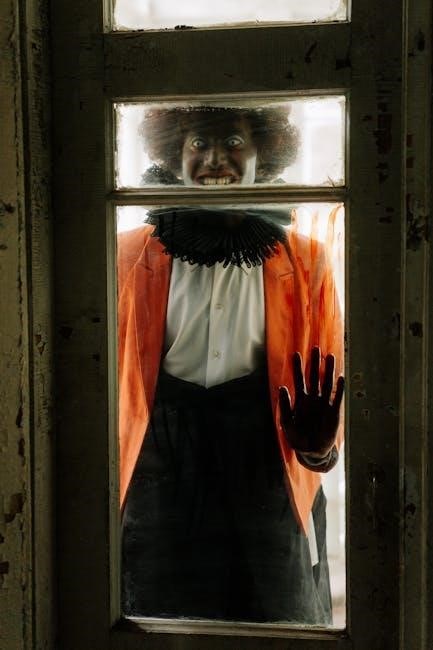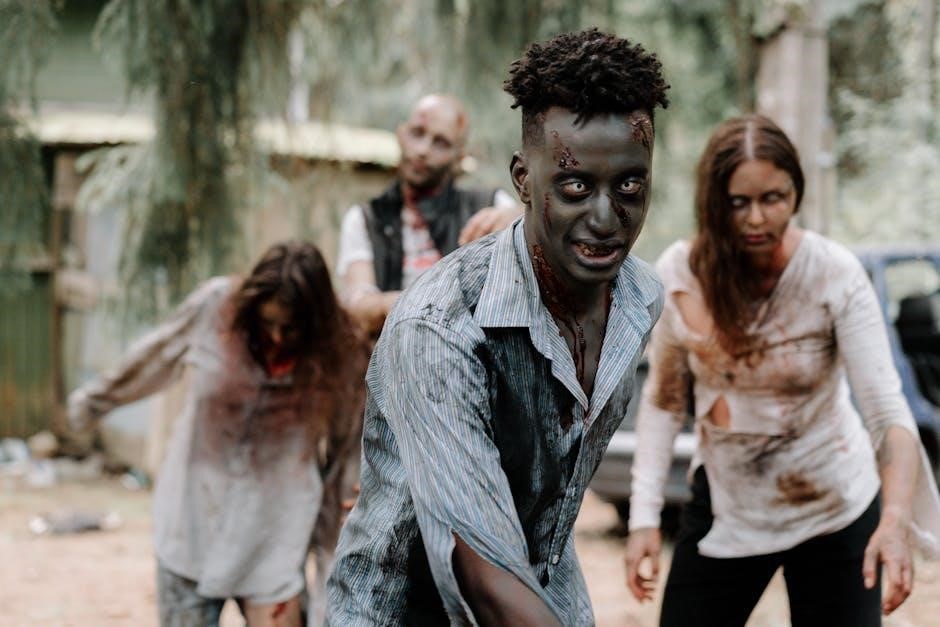
the possibility of evil pdf
Shirley Jackson’s The Possibility of Evil explores the duality of human nature through Miss Strangeworth’s quest to protect her town‚ blending subtle horror with moral ambiguity․ PDF available here․
1․1 Overview of the Short Story
The Possibility of Evil by Shirley Jackson revolves around Miss Strangeworth‚ who attempts to protect her town by uncovering hidden evils through anonymous letters․ Set in 1950s small-town America‚ the story subtly explores moral ambiguity and fear‚ culminating in a disturbing revelation․ The narrative builds suspense through dialogue and a unique point of view‚ highlighting the duality of human nature․ PDF available here․
1․2 Author Background: Shirley Jackson
Shirley Jackson‚ a renowned American author‚ is best known for her horror and supernatural themes․ Born in 1916‚ she gained fame with works like The Lottery and The Haunting of Hill House․ Her 1965 short story‚ The Possibility of Evil‚ reflects her mastery of subtle psychological horror and moral ambiguity․ The story is part of her collection‚ The Magic of Shirley Jackson‚ showcasing her ability to blend suspense with profound insights into human nature․ PDF available here․
1․3 Historical Context: 1950s America
Set in 1950s America‚ The Possibility of Evil reflects the era’s suburban tranquility and social conformity․ The story critiques the moral hypocrisy beneath the surface of small-town life‚ where fear and suspicion lurk․ Jackson’s portrayal of this period highlights the tension between appearances and reality‚ mirroring the societal pressures of the time․ PDF available here․
Themes in “The Possibility of Evil”
The story explores the duality of human nature‚ fear as a motivator‚ and the subtle presence of evil in everyday life․ PDF available here․
2․1 The Nature of Evil
The story portrays evil as subtle and deeply embedded in ordinary life‚ often disguised behind seemingly harmless actions․ Miss Strangeworth’s meddling reveals how even well-intentioned individuals can perpetuate darkness․ The narrative suggests that evil is not monstrous but ingrained in human nature‚ making it harder to identify and confront․ PDF available here․
2․2 Morality and Its Ambiguity
The story highlights the blurred lines between good and evil‚ as Miss Strangeworth’s actions‚ though well-intentioned‚ reveal a darker side of morality․ Her belief in protecting the town often leads to harm‚ questioning the true nature of her intentions․ This ambiguity challenges readers to reflect on how easily moral actions can mask underlying selfishness or malice․ PDF available here․
2․3 Fear as a Motivator for Good
Fear serves as a catalyst for Miss Strangeworth’s actions‚ driving her to expose evil and protect her town․ She believes fear can lead people to moral behavior‚ as seen in her letter-writing campaign․ This mirrors real-world contexts‚ like military training‚ where fear is used to prepare individuals for greater challenges‚ highlighting its dual role in shaping morally driven outcomes․ PDF available here․

Setting and Atmosphere
The story unfolds in a small‚ idyllic 1950s American town‚ creating a sense of tranquility․ However‚ subtle suspense and underlying tension build a haunting atmosphere․ PDF available here․
3․1 Small-Town America in the 1950s
The story is set in a quaint‚ seemingly idyllic American town during the 1950s‚ where everyone knows each other․ The setting creates a sense of normalcy and tranquility‚ with its traditional values and close-knit community․ However‚ this facade hides underlying tensions and subtle horrors‚ reflecting the duality of human nature․ PDF available here․
3․2 Suspense and Subtle Horror
The story masterfully builds suspense through Miss Strangeworth’s intrusive letters and the town’s underlying tensions․ Subtle horror emerges as her actions reveal the darkness beneath the town’s idyllic surface․ The slow-building tension creates unease‚ culminating in a chilling realization about the presence of evil․ Jackson’s technique leaves readers with a lingering sense of dread․ PDF available here․

Character Analysis
Miss Strangeworth‚ the protagonist‚ embodies moral complexity‚ believing she protects her town through intrusive letters․ The townspeople‚ unaware of her meddling‚ represent ordinary lives tainted by subtle evil․ PDF available here․
4․1 Miss Strangeworth: The Protagonist
Miss Strangeworth‚ the story’s central figure‚ believes she protects her town by uncovering evil through anonymous letters․ Her self-appointed role as moral guardian highlights her complex character‚ blending altruism with intrusive meddling․ Her actions reveal a duality‚ as she seeks to expose wrongdoing while maintaining a facade of innocence․ PDF available here․
4․2 The Inhabitants of the Town
The townspeople in The Possibility of Evil are portrayed as ordinary individuals living unsuspectingly‚ unaware of the potential evil nearby․ Their mundane lives are disrupted by Miss Strangeworth’s letters‚ revealing underlying tensions and moral complexities․ The story subtly critiques small-town dynamics‚ where outward normalcy often conceals deeper issues․ PDF available here․

Narrative Structure
The story uses dialogue and a narrative point of view to build suspense‚ exploring the small-town 1950s America setting․ PDF available here․
5․1 Use of Dialogue
Dialogue in The Possibility of Evil reveals character traits and builds suspense․ Miss Strangeworth’s conversations with townsfolk expose her belief in her moral superiority‚ while subtle exchanges hint at underlying tensions․ The PDF version of the story highlights how dialogue underscores the duality of human nature‚ blending innocence with sinister undertones; Read more here․
5․2 Narrative Point of View
The narrative point of view in The Possibility of Evil is third-person limited‚ centered on Miss Strangeworth․ This perspective allows readers to understand her motivations and beliefs‚ creating suspense and highlighting her moral ambiguity․ The PDF version of the story showcases how this narrative style effectively builds tension and explores the duality of human nature․ Read the PDF․

Symbolism and Motifs
The story uses letters as a motif‚ symbolizing Miss Strangeworth’s attempt to uncover evil․ Evil is subtly embedded in everyday life‚ reflecting the duality of human nature․ PDF analysis highlights these elements‚ showcasing Jackson’s mastery of subtle horror and moral complexity․
6․1 The Role of Letters
Letters in The Possibility of Evil symbolize Miss Strangeworth’s tool for uncovering evil‚ reflecting her belief in moral vigilance․ They serve as a medium to expose hidden truths‚ driving the plot’s tension․ The PDF version of the story highlights how these letters reveal the duality of human nature‚ blending subtle horror with moral complexity․ Read more here․
6․2 The Symbolism of Evil in Everyday Life
In The Possibility of Evil‚ evil is depicted as a subtle‚ pervasive force in ordinary life․ Miss Strangeworth’s actions reveal how seemingly harmless individuals can harbor dark intentions․ The story’s setting‚ a quiet 1950s town‚ underscores the idea that evil exists in plain sight‚ hidden behind facades of normalcy․ Explore the PDF for deeper insights․
Plot Analysis
Miss Strangeworth’s mission to uncover evil in her town reveals a complex web of secrets and moral dilemmas‚ highlighting the tension between good intentions and harmful actions․ Read the PDF for a deeper dive into the story’s unfolding events․
7․1 The Quest to Protect the Town
Miss Strangeworth believes she is safeguarding her town by uncovering hidden evils‚ but her methods reveal a morally ambiguous crusade․ Her letters‚ intended to expose wrongdoing‚ blur the line between protection and intrusion‚ raising questions about the true nature of her mission․ Read the PDF for a deeper exploration of her quest and its implications․
7․2 The Unseen Evil Lurking Nearby
The story highlights the subtle‚ unnoticed evils in the town‚ which Miss Strangeworth believes she alone perceives․ Her letters aim to expose these hidden wrongs‚ but her intrusive methods raise questions about morality․ The townspeople‚ oblivious to the lurking dangers‚ continue their lives‚ unaware of the darkness she claims to uncover․ Read the PDF for a deeper dive into this theme․
Character Development
Miss Strangeworth’s belief in her moral duty drives her actions‚ while the townspeople’s growing awareness of evil transforms their collective consciousness․ Read the PDF․
8․1 Miss Strangeworth’s Perception of Evil
Miss Strangeworth views evil as a moral duty to uncover‚ believing her actions protect the town․ She sees herself as a guardian‚ using letters to expose wrongdoing‚ yet her methods blur the line between good and harm․ Her perception of evil is deeply personal‚ reflecting her own duality and the subtle horrors of everyday life․ Read the story to explore her complexities․
8․2 The Transformation of the Town’s Awareness
The town’s awareness evolves as Miss Strangeworth’s letters uncover hidden truths‚ prompting residents to confront evil․ Her actions spark a moral awakening‚ revealing that evil lurks subtly in everyday life․ This transformation highlights the story’s theme of uncovering darkness within ordinary existence‚ leaving the town forever changed in its perception of morality and danger․
Thematic Analysis
Shirley Jackson’s The Possibility of Evil delves into the duality of human nature‚ exploring how fear and morality shape actions‚ revealing the subtle presence of evil in ordinary life․
9․1 The Duality of Human Nature
Shirley Jackson’s The Possibility of Evil masterfully explores the duality of human nature‚ revealing how seemingly benevolent individuals like Miss Strangeworth harbor darker impulses․ Her protective facade conceals intrusive tendencies‚ while the townspeople’s obliviousness to evil highlights the coexistence of good and malevolence in everyday life‚ creating a nuanced moral landscape․
9․2 The Power of Fear in Shaping Actions
Fear serves as a double-edged sword in The Possibility of Evil‚ driving characters to act in ways they perceive as protective or morally just․ Miss Strangeworth’s fear of evil compels her to intervene‚ while the townspeople’s fear of the unknown motivates their compliance․ This dynamic illustrates how fear can both unite and control‚ revealing its complex role in human behavior and decision-making․

The Impact of “The Possibility of Evil”
Shirley Jackson’s story leaves a lasting impact by exploring evil’s subtlety‚ making it a thought-provoking read for educational purposes and sparking discussions on human nature․ PDF available here․
10․1 Legacy of the Story
The Possibility of Evil remains a significant work in American literature‚ often studied in high schools for its subtle horror and moral complexity․ Its exploration of evil’s everyday presence continues to resonate‚ making it a timeless piece for educational analysis․ The story’s enduring legacy lies in its ability to provoke thought on human nature and morality‚ ensuring its relevance across generations․ PDF available here․
10․2 Comparison with Other Works by Shirley Jackson
Shirley Jackson’s The Possibility of Evil shares thematic similarities with her iconic work The Lottery‚ both exploring suspense‚ moral ambiguity‚ and the darker aspects of human nature․ However‚ The Possibility of Evil stands out for its subtle psychological depth and the protagonist’s complex morality‚ offering a unique perspective on evil’s everyday presence․ PDF available here․

Educational Resources
The PDF version of The Possibility of Evil is available for educational use‚ along with study guides and analysis‚ aiding deeper understanding of the story’s themes and structure․
11․1 The PDF Version of the Story
The PDF version of The Possibility of Evil is readily available online‚ providing easy access for readers and educators․ This format preserves the story’s original structure and tone‚ making it ideal for close reading and analysis․ The PDF is particularly useful for students‚ offering a clear and concise version of Shirley Jackson’s work for study purposes․
11․2 Study Guides and Analysis
Study guides and analyses for The Possibility of Evil are widely available online‚ offering insights into the story’s themes‚ characters‚ and plot․ These resources provide detailed breakdowns of Shirley Jackson’s use of suspense‚ moral ambiguity‚ and small-town dynamics․ They are invaluable for students and educators seeking to deepen their understanding of the story’s complexities and its exploration of evil in everyday life․

The Role of Evil in Modern Context
Evil in modern contexts‚ like corporations and governments‚ often hides behind power and fear‚ mirroring the subtle horrors in The Possibility of Evil․ Explore the PDF for deeper insights into its timeless relevance․
12․1 Evil in Businesses and Corporations
Corporations often prioritize profit over morality‚ reflecting a modern form of evil․ The pursuit of wealth can lead to unethical practices‚ mirroring the subtle evil in Jackson’s story․ Explore the PDF to understand how power and fear drive such behaviors‚ echoing Miss Strangeworth’s manipulative actions․
12․2 Evil in Government and Military
Governments and military institutions often wield power that can manifest as evil․ Fear and strict discipline‚ like in military training‚ can be tools for preparation‚ yet their methods may seem harsh․ This mirrors Miss Strangeworth’s belief in using fear for good‚ as seen in the story‚ where moral ambiguity blurs the line between protection and control․

Psychological Aspects of Evil
Miss Strangeworth’s actions reveal a complex psychology‚ blending a sense of duty with underlying fears‚ highlighting how evil can stem from a distorted moral compass․ Read more․
13․1 The Psychology of Miss Strangeworth
Miss Strangeworth’s psychology is marked by a self-appointed role as her town’s moral guardian‚ driven by a mix of altruism and fear․ Her belief in uncovering evil reflects a complex duality‚ where her actions‚ though well-intentioned‚ blur the lines between protection and manipulation․ This duality highlights the subtlety of evil within everyday intentions․ Read more․
13․2 The Psychology of Fear and Morality
Fear often serves as a motivator for moral actions‚ as seen in military training‚ where strict discipline prepares recruits for challenges․ However‚ this duality raises ethical questions about whether fear-driven morality is truly altruistic or self-serving․ The interplay between fear and morality highlights the complexity of human behavior‚ where good intentions can sometimes mask underlying motivations․ Explore more․

The Role of Fear as a Motivator
Fear drives individuals to act morally‚ as seen in military training‚ where strict instructors prepare recruits for challenges‚ blending discipline with the greater good․ Learn more․
14․1 Fear in Military Training
Fear in military training serves as a motivator‚ preparing recruits for challenges․ Strict instructors instill discipline‚ blending tough methods with the greater good‚ as seen in Shirley Jackson’s exploration of moral preparation․ Read more․
14․2 Fear in Achieving Morally Right Goals
Fear can motivate individuals to pursue morally right goals by instilling discipline and urgency․ In The Possibility of Evil‚ Miss Strangeworth uses fear to protect her town‚ believing her actions serve a greater good․ This duality of fear and morality is explored in the story’s PDF‚ highlighting its complex role in achieving righteous outcomes․
The Possibility of Evil masterfully explores the duality of human nature‚ leaving readers contemplating fear‚ morality‚ and the subtle presence of evil in everyday life․ Read the story here to reflect on its timeless themes and moral ambiguity․
15․1 Recap of Key Themes
Shirley Jackson’s The Possibility of Evil delves into the duality of human nature‚ exploring fear‚ morality‚ and the subtle presence of evil in everyday life․ The story highlights how fear can motivate actions‚ revealing the fine line between good and evil․ Miss Strangeworth’s quest to protect her town underscores the ambiguity of moral intentions and the transformative power of awareness․ Read the full story to delve deeper into these themes․
15․2 Final Thoughts on the Possibility of Evil
Shirley Jackson’s The Possibility of Evil leaves readers contemplating the subtle‚ pervasive nature of evil in ordinary life․ Miss Strangeworth’s actions reveal the moral ambiguity of fear as a motivator‚ questioning whether good intentions justify intrusive deeds․ The story’s unsettling conclusion underscores the duality of human nature‚ reminding us that evil often lurks in plain sight‚ disguised as virtue; Explore the full story for deeper insights․


Leave a Reply
You must be logged in to post a comment.